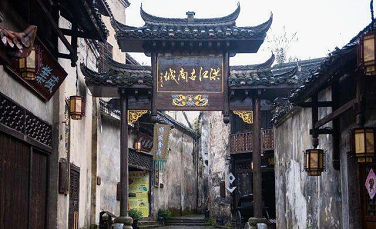Hongjiang Ancient Commercial Town, located on the bank of Yuanshui river, was prosperous because of convenient waterway transportation. It used to be one of the largest, earliest and most complete shopping malls in Southwest China and a leading goods distribution and financial center in the southwest of Hunan, famous for trading timber, tung oil, local medicine and white wax, etc. On currency circulation it was second only to Changsha, the capital city of Hunan. As a result, it had the reputation of “Little Nanjing”, “Pearl of Western Hunan” and “Transportation Hub of Seven Provinces”.

During its peak from the late Qing Dynasty to the early Republic of China, thousands of freighters and wooden rafts were running on the Yuanshui River of Hongjiang, which was boasted by the locals “You can't see nothing else but vessels and rafts on the river”. As a result, Hongjiang enjoyed thriving dock culture with dozens of land and water docks or wharves, which were mainly for stacking, handling, and trading goods. The saying of “forty-eight wharves of eighteen gangs from five prefectures”, meaning merchants from all parts of the country gathered here to do business, fully shows the prosperity of dock culture then. At its peak, porters working on the docks reached 10,000.

Close to the docks is the ancient commercial town, which covers an area of nearly 300,000 square meters. Its scale, majesty, and preservation are rare in China, with over 380 well-preserved old buildings of the Ming and Qing Dynasties, including 18 newspaper offices, 23 banks, 34 schools, 48 stages, 50 brothels, 60 opium dens, as well as hundreds of shops and thousands of workshops. This town is a living museum with a collection of political, military, cultural and religious history, so it is famed as “A Commercial Forbidden City of China”, and “a living fossil of China’s budding capitalism”.

Behind the town are mountains. The entire ancient town is built by the mountains and a river, with uneven terrain and beautiful landscape, reflecting Chinese construction philosophy of pursuing a harmony between man and nature.
However, such a bustling scene mentioned above can’t be found now, for only one-fifth of the original Hongjiang ancient town has been preserved at present. In order to restore the original grand occasion in the history, great efforts are being made by the local authority to rebuild a series of constructions such as docks, guild halls and shops along the Yuanshui river. Now, a 90.94-mu theme park of “Amazing Hongjiang”, planned by Wei Chunyu, dean of the School of Architecture of Hunan University and chairman of the Hunan Design Artists Association, is being under construction.

(Translated by Chen Min)
